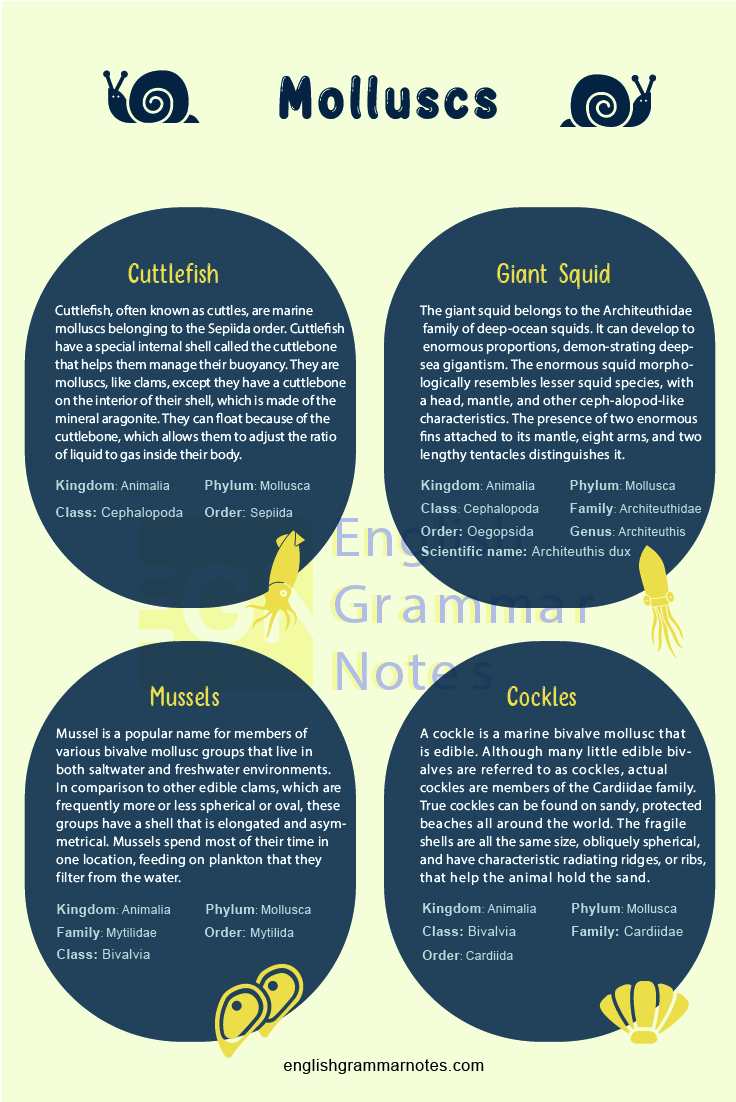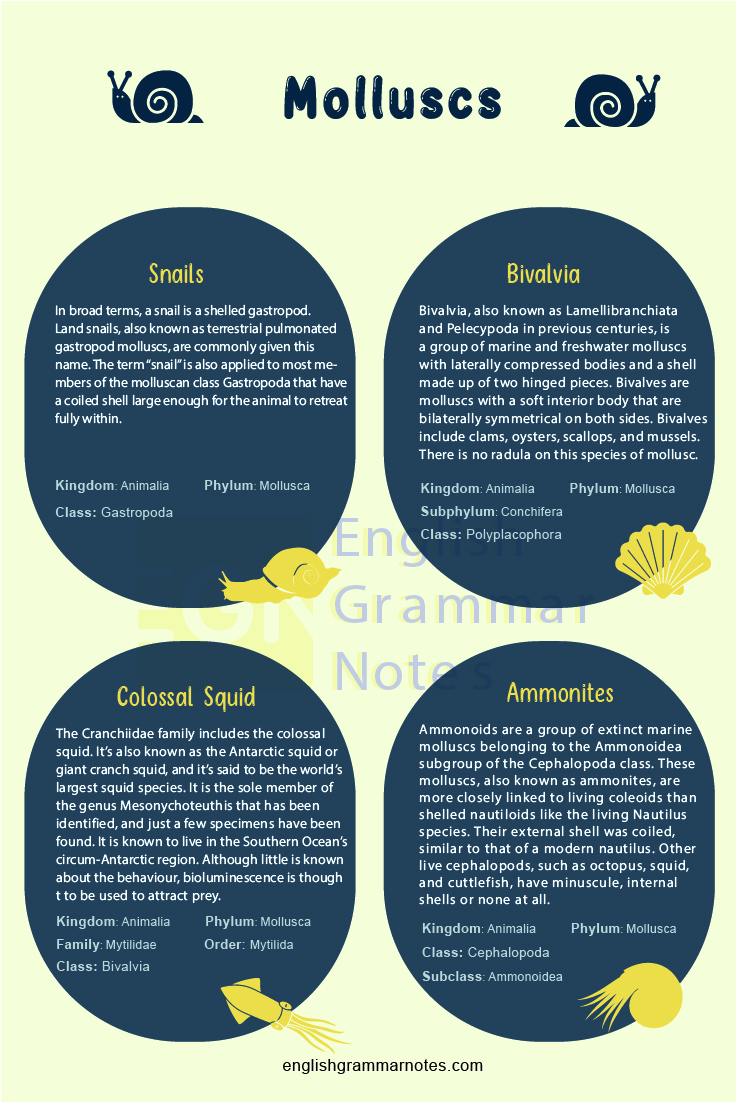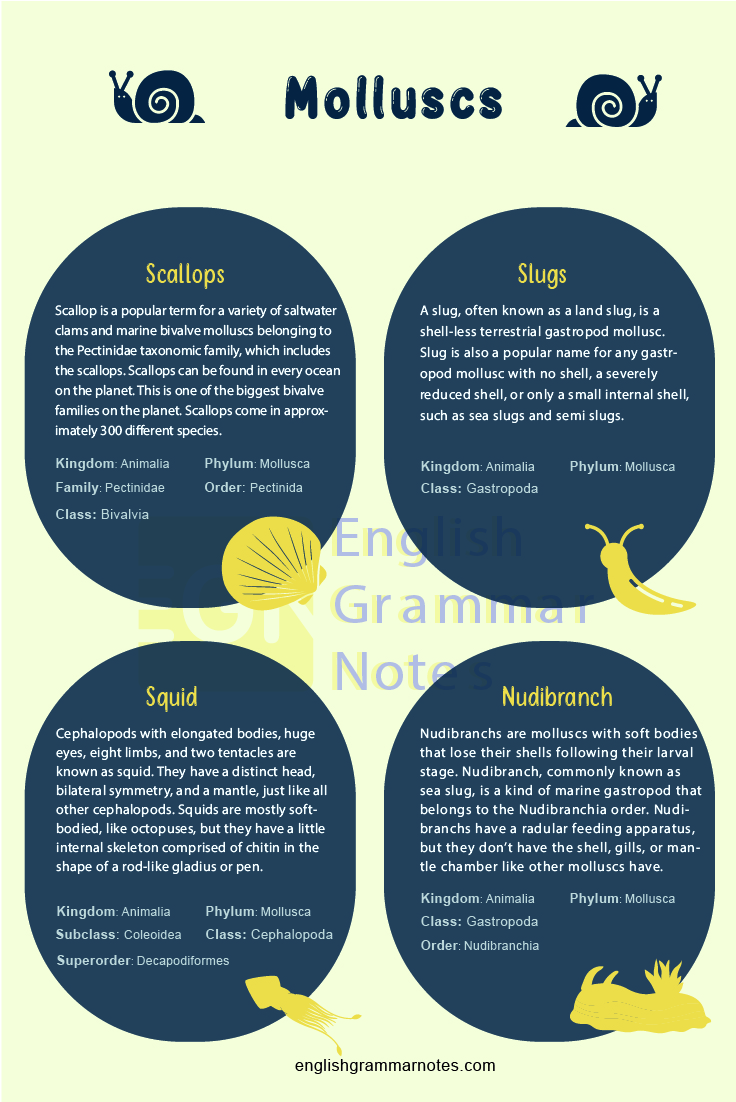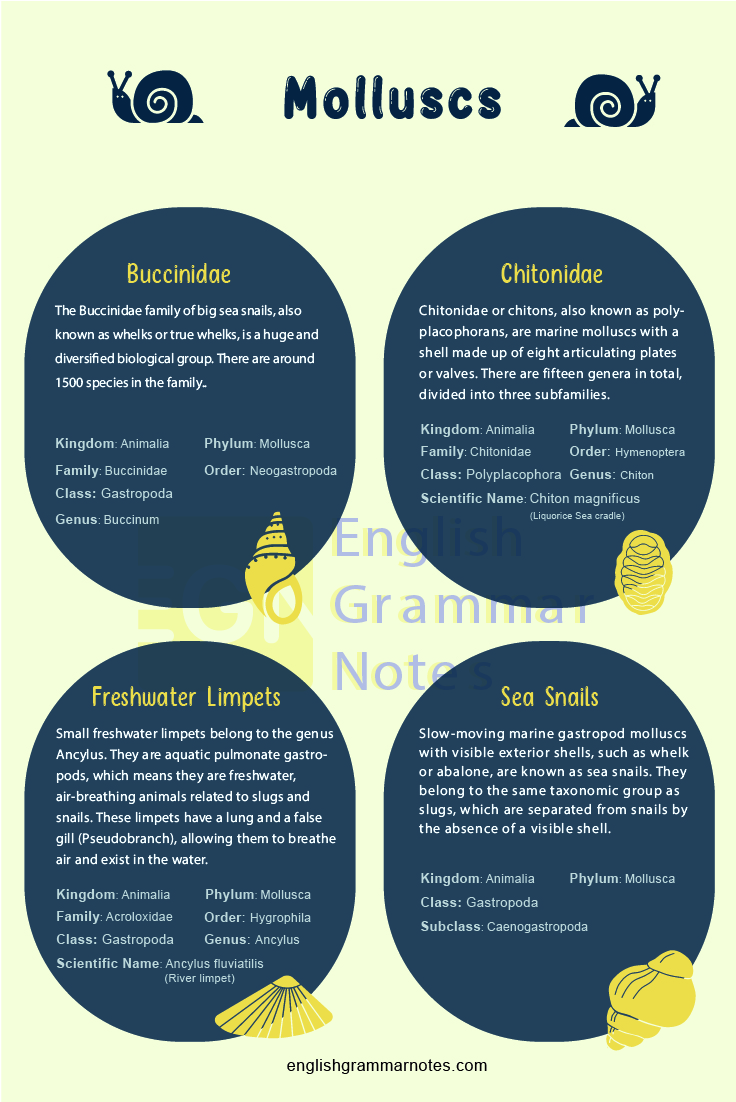Molluscs: You must be wondering what is a mollusc? To answer this question, we can describe molluscs or mollusks as the members of the group Mollusca, which is the second-largest phylum of invertebrate creatures after the Arthropoda.
Molluscs are estimated to number over 85,000 species. Between 60,000 and 100,000 more species are thought to exist in the fossil record.
In other words, a mollusc is a soft-bodied animal such as a snail, slug, mussel, clam, or octopus; and to protect themselves, many molluscs develop hard shells on them.
Study the most important English Vocabulary Words identified by our experts and learn the right vocabulary to use in your day to day conversations
While each organism is very different from another, most of them have similar characteristics. These molluscs characteristics include their habitat, food habits, structure and parts of the body and others.
Hence, we have put together a list of molluscs along with their descriptions and pictures in this article that will help you learn some interesting facts about molluscs.
List of Molluscs
Name of Molluscs
- Ammonites
- Atrina
- Bivalvia
- Buccinidae
- Chitonidae
- Clams
- Cockles
- Coleoids
- Colossal Squid
- Cuttlefish
- Freshwater Limpets
- Giant Squid
- Haliotis
- Helcionelloida
- Monoplacophora
- Mussels
- Nautilidae
- Nautiloid
- Neoloricata
- Nudibranch
- Octopus
- Oysters
- Pinctada
- Pinna
- Scallops
- Sea Butterflies
- Sea Slugs
- Sea Snails
- Shipworm
- Slugs
- Snails
- Squid
- Tresus
- Tusk shells
- Unionidae
Description of the Molluscs on the list
Ammonites
Ammonoids are a group of extinct marine molluscs belonging to the Ammonoidea subgroup of the Cephalopoda class. These molluscs, also known as ammonites, are more closely linked to living coleoids than shelled nautiloids like the living Nautilus species. Their external shell was coiled, similar to that of a modern nautilus. Other live cephalopods, such as octopus, squid, and cuttlefish, have minuscule, internal shells or none at all.
| Kingdom | Animalia |
| Phylum | Mollusca |
| Class | Cephalopoda |
| Subclass | Ammonoidea |
Atrina
Atrina is a worldwide bivalve mollusc genus belonging to the Pinnidae family. Within the Pinnidae, Atrina is thought to represent the more primordial form; yet, both Pinna and Atrina are very old genera. Molluscs in this genus have elongated, wedge-shaped shells, which are distinguishable from those in the genus Pinna by the lack of grooves in the nacreous lining and the central placement of the adductor scar.
| Kingdom | Animalia |
| Phylum | Mollusca |
| Class | Bivalvia |
| Order | Pteriida |
| Family | Pinnidae |
| Genus | Atrina |
Bivalvia
Bivalvia, also known as Lamellibranchiata and Pelecypoda in previous centuries, is a group of marine and freshwater molluscs with laterally compressed bodies and a shell made up of two hinged pieces. Bivalves are molluscs with a soft interior body that are bilaterally symmetrical on both sides. Bivalves include clams, oysters, scallops, and mussels. There is no radula on this species of mollusc.
| Kingdom | Animalia |
| Phylum | Mollusca |
| Subphylum | Conchifera |
| Class | Bivalvia |
Buccinidae
The Buccinidae family of big sea snails, also known as whelks or true whelks, is a huge and diversified biological group. There are around 1500 species in the family.
| Kingdom | Animalia |
| Phylum | Mollusca |
| Class | Gastropoda |
| Order | Neogastropoda |
| Family | Buccinidae |
| Genus | Buccinum |
Chitonidae
Chitonidae or chitons, also known as polyplacophorans, are marine molluscs with a shell made up of eight articulating plates or valves. There are fifteen genera in total, divided into three subfamilies.
| Kingdom | Animalia |
| Phylum | Mollusca |
| Class | Polyplacophora |
| Order | Chitonida |
| Family | Chitonidae |
| Genus | Chiton |
| Scientific name | Chiton magnificus (Liquorice Sea cradle) |
Clams
Clam is a generic term for a variety of bivalve molluscs. The term is frequently applied only to edible infauna that spends the majority of their lives partially buried in the sand of the seafloor or riverbeds. True clams are bivalves with equal shells closed by two adductor muscles at opposite ends of the shell and a robust, muscular burrowing foot in the strict sense.
| Kingdom | Animalia |
| Phylum | Mollusca |
| Class | Bivalvia |
| Order | Veneroida |
| Family | Corbiculidae |
| Genus | Corbicula |
| Scientific name | Corbicula fluminea (Asian clam) |
Cockles
A cockle is a marine bivalve mollusc that is edible. Although many little edible bivalves are referred to as cockles, actual cockles are members of the Cardiidae family. True cockles can be found on sandy, protected beaches all around the world. The fragile shells are all the same size, obliquely spherical, and have characteristic radiating ridges, or ribs, that help the animal hold the sand.
| Kingdom | Animalia |
| Phylum | Mollusca |
| Class | Bivalvia |
| Order | Cardiida |
| Family | Cardiidae |

Coleoids
Coleoidea, or Dibranchiata, is a subclass of cephalopods that includes all of the species that are commonly referred to as “soft-bodied” or “shell-less.” Coleoidea are carnivorous cephalopods that eat other cephalopods, crabs, molluscs, and tiny fish.
| Kingdom | Animalia |
| Phylum | Mollusca |
| Class | Cephalopoda |
| Subclass | Coleoidea |
Colossal Squid
The Cranchiidae family includes the colossal squid. It’s also known as the Antarctic squid or giant cranch squid, and it’s said to be the world’s largest squid species. It is the sole member of the genus Mesonychoteuthis that has been identified, and just a few specimens have been found. It is known to live in the Southern Ocean’s circum-Antarctic region. Although little is known about the behaviour, bioluminescence is thought to be used to attract prey.
| Kingdom | Animalia |
| Phylum | Mollusca |
| Class | Cephalopoda |
| Order | Oegopsida |
| Family | Cranchiidae |
| Genus | Mesonychoteuthis |
| Scientific name | Mesonychoteuthis hamiltoni |

Cuttlefish
Cuttlefish, often known as cuttles, are marine molluscs belonging to the Sepiida order. Cuttlefish have a special internal shell called the cuttlebone that helps them manage their buoyancy. They are molluscs, like clams, except they have a cuttlebone on the interior of their shell, which is made of the mineral aragonite. They can float because of the cuttlebone, which allows them to adjust the ratio of liquid to gas inside their body.
| Kingdom | Animalia |
| Phylum | Mollusca |
| Class | Cephalopoda |
| Order | Sepiida |
Freshwater Limpets
Small freshwater limpets belong to the genus Ancylus. They are aquatic pulmonate gastropods, which means they are freshwater, air-breathing animals related to slugs and snails. These limpets have a lung and a false gill (Pseudobranch), allowing them to breathe air and exist in the water.
| Kingdom | Animalia |
| Phylum | Mollusca |
| Class | Gastropoda |
| Order | Hygrophila |
| Family | Acroloxidae |
| Genus | Ancylus |
| Scientific name | Ancylus fluviatilis (River limpet) |
Giant Squid
The giant squid belongs to the Architeuthidae family of deep-ocean squids. It can develop to enormous proportions, demonstrating deep-sea gigantism. The enormous squid morphologically resembles lesser squid species, with a head, mantle, and other cephalopod-like characteristics. The presence of two enormous fins attached to its mantle, eight arms, and two lengthy tentacles distinguishes it.
| Kingdom | Animalia |
| Phylum | Mollusca |
| Class | Cephalopoda |
| Order | Oegopsida |
| Family | Architeuthidae |
| Genus | Architeuthis |
| Scientific name | Architeuthis dux |
Haliotis
Haliotis, also known as abalone, is the only genus in the Haliotidae family. There were six subgenera in this genus at one time. These subgenera have evolved into alternative Haliotis representations. Small to extremely big edible herbivorous sea snails, marine gastropod molluscs, make up the genus.
| Kingdom | Animalia |
| Phylum | Mollusca |
| Class | Gastropoda |
| Subclass | Vetigastropoda |
| Clade | Lepetellida |
| Superfamily | Haliotoidea |
| Family | Haliotidae |
| Genus | Haliotis |
| Scientific name | Haliotis asinina |
Helcionelloida
Helcionelloida is a group of extinct ancient molluscs. These are the oldest conchiferan molluscs known to have a mineralised shell. Monoplacophorans were mistaken for certain members of this class. These animals possessed a coiled and cone-shaped shell. The vast majority of the species were diminutive. They are now depicted as snails in modern reconstructions.
| Kingdom | Animalia |
| Phylum | Mollusca |
| Subphylum | Conchifera |
| Class | Helcionelloida |
Monoplacophora
Monoplacophora, which means “carrying one plate,” is a polyphyletic superclass of molluscs with a cap-like shell that now lives at the deep sea’s bottom. Monoplacophorans are unique in that they have a unique blend of basic traits. They have paired numerous organs in addition to the single cap-shaped shell, indicating at least partial segmentation.
| Kingdom | Animalia |
| Phylum | Mollusca |
| Subphylum | Conchifera |
| Class | Monoplacophora |
Mussels
Mussel is a popular name for members of various bivalve mollusc groups that live in both saltwater and freshwater environments. In comparison to other edible clams, which are frequently more or less spherical or oval, these groups have a shell that is elongated and asymmetrical. Mussels spend most of their time in one location, feeding on plankton that they filter from the water.
| Kingdom | Animalia |
| Phylum | Mollusca |
| Class | Bivalvia |
| Order | Mytilida |
| Family | Mytilidae |
Nautilidae
The nautilus is a pelagic marine mollusc belonging to the Nautilidae family of cephalopods. Extant and extinct members of the Nautilidae family have smooth involute or more or less convolute shells with compressed or depressed whorl sections, straight to sinuous sutures, and a tubular, generally central siphuncle.
| Kingdom | Animalia |
| Phylum | Mollusca |
| Class | Cephalopoda |
| Order | Nautilida |
| Family | Nautilidae |
Nautiloid
The live Nautilus and Allonautilus are members of the Nautiloidea subclass, which began in the Late Cambrian and includes a huge and diversified collection of marine cephalopods. There are about 2,500 different species of fossil nautiloids, but only a few of them have survived to this day.
| Kingdom | Animalia |
| Phylum | Mollusca |
| Class | Cephalopoda |
| Subclass | Nautiloidea |
Neoloricata
Neoloricata includes living polyplacophoran molluscs as well as a few species only known from fossils.
| Kingdom | Animalia |
| Phylum | Mollusca |
| Class | Polyplacophora |
| Subclass | Neoloricata |
Nudibranch
Nudibranchs are molluscs with soft bodies that lose their shells following their larval stage. Nudibranch, commonly known as sea slug, is a kind of marine gastropod that belongs to the Nudibranchia order. Nudibranchs have a radular feeding apparatus, but they don’t have the shell, gills, or mantle chamber like other molluscs have.
| Kingdom | Animalia |
| Phylum | Mollusca |
| Class | Gastropoda |
| Order | Nudibranchia |

Octopus
Octopuses are soft-bodied, eight-limbed molluscs belonging to the Octopoda order. Squids, cuttlefish, and nautiloids are all members of the Cephalopoda class, which includes over 300 species.
Octopuses are sea animals with eight limbs and bulbous heads that are well-known. They have three hearts and blue blood, spew ink to ward off predators, and are boneless, allowing them to get into (or out of) tiny areas. They have been spotted utilising tools and are extremely clever.
| Kingdom | Animalia |
| Phylum | Mollusca |
| Class | Cephalopoda |
| Order | Octopoda |
Oysters
Oyster is the common term for a variety of saltwater bivalve mollusc families that dwell in marine or brackish environments. The valves of certain species are heavily calcified, and many are irregular in form. The superfamily Ostreoidea includes many oysters, but not all.
Oyster shells are typically oval or pear-shaped, although they can take on a variety of shapes depending on what they’re attached to. The outside of their shell is normally whitish-grey, while the inside is usually porcelain white. When threatened, they use their powerful adductor muscles to shut their shells.
| Kingdom | Animalia |
| Phylum | Mollusca |
| Class | Bivalvia |
| Subclass | Pteriomorphia |
Pinctada
Pinctada is a genus of saltwater oysters that belong to the Pteriidae family of marine bivalve molluscs. The inner shell layer of these pearl oysters is made of nacre, commonly known as the “mother of pearl.” Pearls are produced by all species in the genus.
| Kingdom | Animalia |
| Phylum | Mollusca |
| Class | Bivalvia |
| Order | Pteriida |
| Family | Pteriidae |
| Genus | Pinctada |
Pinna
Pinna is a genus of bivalve molluscs in the Pinnidae family. Pinna rudis is the genus’ type species. Thin, elongated, wedge-shaped, nearly triangular shells with long, toothed edges distinguish them. The shells have radial ribs running the length of their surface.
| Kingdom | Animalia |
| Phylum | Mollusca |
| Class | Bivalvia |
| Order | Pteriida |
| Family | Pinnidae |
| Genus | Pinna |
| Scientific name | Pinna nobilis (Noble pen shell) |
Scallops
Scallop is a popular term for a variety of saltwater clams and marine bivalve molluscs belonging to the Pectinidae taxonomic family, which includes the scallops. Scallops can be found in every ocean on the planet. This is one of the biggest bivalve families on the planet. Scallops come in approximately 300 different species.
| Kingdom | Animalia |
| Phylum | Mollusca |
| Class | Bivalvia |
| Order | Pectinida |
| Family | Pectinidae |
Sea Butterflies
Thecosomata, or sea butterflies, are a biological suborder of small pelagic swimming sea snails. These holoplanktonic opisthobranch gastropod molluscs belong to the Opisthobranchia informal group. They contain some of the most abundant gastropod species on the planet. It’s a tiny shelled sea snail that swims with the help of a pair of modified feet that act as wings.
| Kingdom | Animalia |
| Phylum | Mollusca |
| Class | Gastropoda |
| Subclass | Heterobranchia |
| Clade | Euopisthobranchia, Thecosomata |
Sea Slugs
The term “sea slug” refers to a group of marine organisms that bear varying degrees of resemblance to terrestrial slugs. Most sea slugs are gastropods, which are sea snails (marine gastropod molluscs) that have either fully lost their shells or appeared to have lost their shells due to a severely reduced or internal shell during evolutionary time.
| Kingdom | Animalia |
| Phylum | Mollusca |
| Class | Gastropoda |
| Order | Nudibranchia |
| Clade | Euctenidiacea, Dexiarchia |
Sea Snails
Slow-moving marine gastropod molluscs with visible exterior shells, such as whelk or abalone, are known as sea snails. They belong to the same taxonomic group as slugs, which are separated from snails by the absence of a visible shell.
| Kingdom | Animalia |
| Phylum | Mollusca |
| Class | Gastropoda |
| Subclass | Caenogastropoda |

Shipworm
Shipworms come under Teredinidae, a family of saltwater clams with long, soft, bare bodies. Shipworms are marine bivalve molluscs in the family Teredinidae. Shipworms are found in most oceans and seas, and their presence is significant due to the damage they do to wooden ship hulls, wharves, and other submerged wooden structures.
| Kingdom | Animalia |
| Phylum | Mollusca |
| Class | Bivalvia |
| Subclass | Heterodonta |
| Superorder | Imparidentia |
| Order | Myida |
| Superfamily | Pholadoidea |
| Family | Teredinidae |
Slugs
A slug, often known as a land slug, is a shell-less terrestrial gastropod mollusc. Slug is also a popular name for any gastropod mollusc with no shell, a severely reduced shell, or only a small internal shell, such as sea slugs and semi slugs.
| Kingdom | Animalia |
| Phylum | Mollusca |
| Class | Gastropoda |
Snails
In broad terms, a snail is a shelled gastropod. Land snails, also known as terrestrial pulmonated gastropod molluscs, are commonly given this name. The term “snail” is also applied to most members of the molluscan class Gastropoda that have a coiled shell large enough for the animal to retreat fully within.
| Kingdom | Animalia |
| Phylum | Mollusca |
| Class | Gastropoda |
Squid
Cephalopods with elongated bodies, huge eyes, eight limbs, and two tentacles are known as squid. They have a distinct head, bilateral symmetry, and a mantle, just like all other cephalopods. Squids are mostly soft-bodied, like octopuses, but they have a little internal skeleton comprised of chitin in the shape of a rod-like gladius or pen.
| Kingdom | Animalia |
| Phylum | Mollusca |
| Class | Cephalopoda |
| Subclass | Coleoidea |
| Superorder | Decapodiformes |
Tresus
Tresus is a genus of saltwater clams belonging to the Mactridae family of marine bivalve molluscs. Many of them are commonly referred to as horse clams or as gaper clam species. Geoducks are similar to them.
| Kingdom | Animalia |
| Phylum | Mollusca |
| Class | Bivalvia |
| Order | Venerida |
| Family | Mactridae |
| Genus | Tresus |
| Scientific name | Tresus nuttallii (Pacific gaper) |
Tusk shells
Tusk shell, also known as elephant’s tusk, elephant’s tooth, or tooth shell, is a marine mollusc belonging to the Scaphopoda class. There are more than 350 species of tusk shells in four genera (Dentalium is the most frequent). The shells of species in this class range in length from 0.5 to 15 cm.
Tusk shells are elongated, symmetrical organisms with a tubular, tusk-like shell that is open on both ends. The animals breathe through the body surface and are encased in a tubular mantle.
| Kingdom | Animalia |
| Phylum | Mollusca |
| Subphylum | Conchifera |
| Class | Scaphopoda |
| Order | Dentaliida, Gadilida |
Unionidae
The Unionidae is the biggest family of freshwater mussels in the Unionida order of bivalve molluscs, also known as river mussels or simply unionids. This family’s spectrum of distribution is extensive.
| Kingdom | Animalia |
| Phylum | Mollusca |
| Class | Bivalvia |
| Order | Unionida |
| Family | Unionidae |